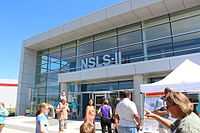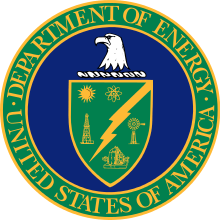Brookhaven National Laboratory
 | |
|
An aerial view of BNL. The prominent ring under construction is the National Synchrotron Light Source 2 (NSLS-II). | |
| Motto | "Passion for discovery" |
|---|---|
| Established | 1947 |
| Research type | Nuclear physics, material physics and chemistry, environmental and biological research |
| Budget | Over US$700 million (2013) |
| Director | Doon Gibbs |
| Staff | 3,000 |
| Location |
Upton, Suffolk County, New York, United States |
| Campus | 21 km2 (5,265 acres) |
Operating agency | Brookhaven Science Associates, LLC |
| Website | www.bnl.gov |
Brookhaven National Laboratory (BNL) is a United States national laboratory located in Upton, New York, on Long Island, and was formally established in 1947 at the site of Camp Upton, a former U.S. Army base. Its name stems from its location in the greater area of the Town of Brookhaven.
Operation
Brookhaven, which originally was owned by the Atomic Energy Commission, is now owned by the Commission's successor, the United States Department of Energy, which subcontracts the actual research and operation to universities and research organizations. It is currently operated by Brookhaven Science Associates LLC, which is an equal partnership of Stony Brook University and Battelle Memorial Institute. It was operated by Associated Universities, Inc. (AUI), from 1947 until 1998 when Associated lost the contract in the wake of a scandal when tritium leaked into the Long Island Central Pine Barrens groundwater on which it sits.[1]
Co-located with the laboratory is the Upton, New York forecast office of the National Weather Service.
BNL is staffed by approximately 3,000 scientists, engineers, technicians, and support personnel, and hosts 4,000 guest investigators every year.[2] Discoveries made at the lab have won seven Nobel Prizes.[3]
The laboratory has its own police station, fire department, and ZIP code (11973). In total, the lab spans a 5,265-acre (21 km2) area. BNL is served by a rail spur operated as-needed by the New York and Atlantic Railway.
History

Brookhaven National Laboratory was established in 1947 on the site of Camp Upton, a training center during both World War I and World War II. After the latter war, the camp was deemed no longer necessary. Meanwhile, discussions were underway for the creation of a new science facility that would focus on the peaceful uses of atomic energy. For this task a nonprofit corporation was established that consisted of representatives from nine major research universities — Columbia, Cornell, Harvard, Johns Hopkins, MIT, Princeton, Penn, Rochester, and Yale University. With the corporation finding the Camp Upton site ideal in terms of space and transportation, a plan was conceived to convert the military camp into a research facility.
On March 21, 1947, the Camp Upton site was officially transferred from the U.S. War Department to the new U.S. Atomic Energy Commission (AEC), predecessor to the U.S. Department of Energy (DOE).
Major programs
Although originally conceived as a nuclear research facility, its mission has greatly expanded. Its foci are now:

- Nuclear and high-energy physics[4]
- Physics and chemistry of materials[5]
- Environmental[6] and energy research
- Nonproliferation[7]
- Neurosciences and medical imaging[8]
- Structural biology[9]
Major facilities
- Relativistic Heavy Ion Collider (RHIC), which was designed to research quark–gluon plasma.[10] Until 2008 it was the world's most powerful particle accelerator.
- Center for Functional Nanomaterials (CFN), it is used for the study of nanoscale materials.[11]

- National Synchrotron Light Source (NSLS), the lab's most popular machine which is said to have attracted more researchers in the world than any other facility.[12] It was involved in the work that won the 2003 Nobel Prize in Chemistry.[13]
- Alternating Gradient Synchrotron, a particle accelerator that was used in three of the lab's Nobel prizes.[14]
- Accelerator Test Facility, generates, accelerates and monitors particle beams.[15]
- Tandem Van de Graaff, once the world's largest electrostatic accelerator.[16]
- New York Blue Gene supercomputer, an 18 rack Blue Gene/L and a 2 rack Blue Gene/P massively parallel supercomputer that involves a cooperative effort between Brookhaven National Laboratory and Stony Brook University.[17] It is the world's 5th fastest supercomputer and the world's 2nd most powerful for open access research as of 2008.[18]
Plans

The lab is building NSLS-II, which in 2015 will replace the NSLS after more than 30 years of operation.[19]
Off-site contributions
It is a contributing partner to ATLAS experiment, one of the four detectors located at the Large Hadron Collider (LHC). It is currently operating at CERN near Geneva, Switzerland.
Brookhaven is also responsible for the design of the SNS accumulator ring in partnership with Spallation Neutron Source in Oak Ridge, Tennessee.
Public access
For other than approved Public Events the Laboratory is closed to the general public. The lab is open to the public on Sundays during the summer for tours and special programs. The public access program is referred to as 'Summer Sundays' and takes place from mid-July to mid-August, and features a science show and a tour of the facilities. The laboratory also hosts science fairs, science bowls, and robotics competitions for local schools. The Lab estimates that each year it enhances the science education of roughly 24,000 kindergarten to 12th grade LI students, more than 100 undergraduates, and 550 teachers from across the United States.
Controversy
In January 1997, ground water samples taken by BNL staff revealed concentrations of tritium that were twice the allowable federal drinking water standards—some samples taken later were 32 times the standard. The tritium was found to be leaking from the laboratory's High Flux Beam Reactor's spent-fuel pool into the aquifer that provides drinking water for nearby Suffolk County residents.
DOE's and BNL's investigation of this incident concluded that the tritium had been leaking for as long as 12 years without DOE's or BNL's knowledge. Installing wells that could have detected the leak was first discussed by BNL engineers in 1993, but the wells were not completed until 1996. The resulting controversy about both BNL's handling of the tritium leak and perceived lapses in DOE's oversight led to the termination of AUI as the BNL contractor in May 1997.
The responsibility for failing to discover Brookhaven's tritium leak has been acknowledged by laboratory managers, and DOE admits it failed to properly oversee the laboratory's operations. Brookhaven officials repeatedly treated the need for installing monitoring wells that would have detected the tritium leak as a low priority despite public concern and the laboratory's agreement to follow local environmental regulations. DOE's on-site oversight office, the Brookhaven Group, was directly responsible for Brookhaven's performance, but it failed to hold the laboratory accountable for meeting all of its regulatory commitments, especially its agreement to install monitoring wells. Senior DOE leadership also shared responsibility because they failed to put in place an effective system that encourages all parts of DOE to work together to ensure that contractors meet their responsibilities on environmental, safety and health issues. Unclear responsibilities for environment, safety and health matters has been a recurring problem for DOE management.
Nobel Prizes
Nobel Prize in Physics
- 1957 – Chen Ning Yang and Tsung-Dao Lee – parity laws[20]
- 1976 – Samuel C. C. Ting – Psi particle[21]
- 1980 – James Cronin and Val Logsdon Fitch – CP-violation[22]
- 1988 – Leon M. Lederman, Melvin Schwartz, Jack Steinberger – Muon neutrino[23]
- 2002 – Raymond Davis, Jr. – Neutrino oscillation[24]
Nobel Prize in Chemistry
- 2003 – Roderick MacKinnon – Ion channel[13]
- 2009 – Venkatraman Ramakrishnan and Thomas A. Steitz – Ribosome[25]
See also
- Center for the Advancement of Science in Space—operates the US National Laboratory on the ISS.
- Tennis for Two[26][27]
- Goldhaber fellows
References
- ↑ Atomic Laboratory on Long Island to Be Mighty Research Center – New York Times – March 1, 1947
- ↑ "About BNL". Bnl.gov. Retrieved 2012-07-25.
- ↑ "Nobel Prizes at BNL". Bnl.gov. Retrieved 2012-07-25.
- ↑ "Physics Department". Bnl.gov. 2008-05-12. Retrieved 2010-03-17.
- ↑ "Homepage, Basic Energy Sciences Directorate". Bnl.gov. Retrieved 2010-03-17.
- ↑ "Environmental Sciences Department". Bnl.gov. 2009-02-04. Retrieved 2010-03-17.
- ↑ "Brookhaven National Laboratory Nonproliferation and National Security Programs". Bnl.gov. 2010-02-02. Retrieved 2010-03-17.
- ↑ "Radiotracer Chemistry and Instrumentation for Biological Imaging". Bnl.gov. Retrieved 2010-03-17.
- ↑ "Biology Department – Brookhaven National Laboratory". Biology.bnl.gov. Retrieved 2010-03-17.
- ↑ "RHIC | Relativistic Heavy Ion Collider". Bnl.gov. Retrieved 2010-03-17.
- ↑ "Center for Functional Nanomaterials, Brookhaven National Laboratory". Bnl.gov. Retrieved 2010-03-17.
- ↑ "National Synchrotron Light Source". Nsls.bnl.gov. Retrieved 2010-03-17.
- ↑ 13.0 13.1 "Nobel Prize | 2003 Chemistry Prize, Roderick MacKinnon". Bnl.gov. Retrieved 2010-03-17.
- ↑ "Alternating Gradient Synchrotron". Bnl.gov. 2008-01-31. Retrieved 2010-03-17.
- ↑ "Accelerator Test Facility". Bnl.gov. 2008-01-31. Retrieved 2010-03-17.
- ↑ "Tandem Van de Graaff". Bnl.gov. 2008-02-28. Retrieved 2010-03-17.
- ↑ New York Blue Gene supercomputer
- ↑ "Computing Power for Scientific Discovery" (PDF). BNL.gov. Retrieved August 4, 2010.
- ↑ "NSLS-II: The Furture National Synchrotron Light Source". bnl.gov. Retrieved August 4, 2010.
- ↑ "Nobel Prize | 1957 Physics Prize, Lee and Yang". Bnl.gov. Retrieved 2010-03-17.
- ↑ "Nobel Prize | 1976 Prize in Physics, Samuel Ting". Bnl.gov. Retrieved 2010-03-17.
- ↑ "Nobel Prize | 1980 Physics Prize, Cronin and Fitch". Bnl.gov. Retrieved 2010-03-17.
- ↑ "Nobel Prize | 1988 Prize in Physics, Lederman, Schwartz and Steinberger". Bnl.gov. Retrieved 2010-03-17.
- ↑ "Nobel Prize | 2002 Physics Prize, Raymond Davis jr". Bnl.gov. Retrieved 2010-03-17.
- ↑ "Nobel Prize | 2009 Chemistry Prize, Venkatraman Ramakrishnan and Thomas A. Steitz". Bnl.gov. Retrieved 2010-05-20.
- ↑ "The anatomy of the first video game - On the Level". MSNBC. 2008-10-23. Retrieved 2010-03-17.
- ↑ "'+alt+'". Bnl.gov. Retrieved 2010-03-17.
External links
| Wikimedia Commons has media related to Brookhaven National Laboratory. |
- Brookhaven National Lab Official Website
- Physics Today: DOE Shuts Brookhaven Lab’s HFBR in a Triumph of Politics Over Science 404
- Summer Sundays at Brookhaven National Laboratory
- Annotated bibliography for Brookhaven Laboratory from the Alsos Digital Library for Nuclear Issues
- Headlines
Coordinates: 40°52′24″N 72°52′19″W / 40.873346°N 72.872057°W
| |||||||||||||||||||||||||||||||||||||||||
| ||||||||||||||||

